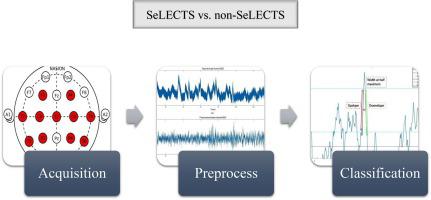当前位置:
X-MOL 学术
›
Brain Res.
›
论文详情
Our official English website, www.x-mol.net, welcomes your feedback! (Note: you will need to create a separate account there.)
Classification of self-limited epilepsy with centrotemporal spikes by classical machine learning and deep learning based on electroencephalogram data
Brain Research ( IF 2.9 ) Pub Date : 2024-02-17 , DOI: 10.1016/j.brainres.2024.148813 Xi Liu , Xinming Zhang , Tao Yu , Ruochen Dang , Jian Li , Bingliang Hu , Quan Wang , Rong Luo
Brain Research ( IF 2.9 ) Pub Date : 2024-02-17 , DOI: 10.1016/j.brainres.2024.148813 Xi Liu , Xinming Zhang , Tao Yu , Ruochen Dang , Jian Li , Bingliang Hu , Quan Wang , Rong Luo

|
Electroencephalogram (EEG) has been widely utilized as a valuable assessment tool for diagnosing epilepsy in hospital settings. However, clinical diagnosis of patients with self-limited epilepsy with centrotemporal spikes (SeLECTS) is challenging due to the presence of similar abnormal discharges in EEG displays compared to other types of epilepsy (non-SeLECTS) patients. To assist the diagnostic process of epilepsy, a comprehensive classification study utilizing machine learning or deep learning techniques is proposed. In this study, clinical EEG was collected from 33 patients diagnosed with either SeLECTS or non-SeLECTS, aged between 3 and 11 years. In the realm of classical machine learning, sharp wave features (including upslope, downslope, and width at half maximum) were extracted from the EEG data. These features were then combined with the random forest (RF) and extreme random forest (ERF) classifiers to differentiate between SeLECTS and non-SeLECTS. Additionally, deep learning was employed by directly inputting the EEG data into a deep residual network (ResNet) for classification. The classification results were evaluated based on accuracy, F1-score, area under the curve (AUC), and area under the precision-recall curve (AUPRC). Following a 10-fold cross-validation, the ERF classifier achieved an accuracy of 73.15 % when utilizing sharp wave feature extraction for classification. The F1-score obtained was 0.72, while the AUC and AUPRC values were 0.75 and 0.63, respectively. On the other hand, the ResNet model achieved a classification accuracy of 90.49 %, with an F1-score of 0.90. The AUC and AUPRC values for ResNet were found to be 0.96 and 0.92, respectively. These results highlighted the significant potential of deep learning methods in SeLECTS classification research, owing to their high accuracy. Moreover, feature extraction-based methods demonstrated good reliability and could assist in identifying relevant biological features of SeLECTS within EEG data.
中文翻译:

基于脑电图数据的经典机器学习和深度学习对中央颞区棘波自限性癫痫的分类
脑电图(EEG)已被广泛用作医院环境中诊断癫痫的有价值的评估工具。然而,中央颞区棘波自限性癫痫(SeLECTS)患者的临床诊断具有挑战性,因为与其他类型的癫痫(非 SeLECTS)患者相比,脑电图显示中存在类似的异常放电。为了协助癫痫的诊断过程,提出了利用机器学习或深度学习技术的综合分类研究。在这项研究中,收集了 33 名诊断为 SeLECTS 或非 SeLECTS 的患者的临床脑电图,年龄在 3 至 11 岁之间。在经典机器学习领域,从脑电图数据中提取尖锐的波特征(包括上坡、下坡和半峰宽度)。然后将这些特征与随机森林 (RF) 和极端随机森林 (ERF) 分类器相结合,以区分 SeLECTS 和非 SeLECTS。此外,还采用深度学习,将脑电图数据直接输入深度残差网络(ResNet)进行分类。根据准确度、F1 分数、曲线下面积 (AUC) 和精确召回曲线下面积 (AUPRC) 评估分类结果。经过 10 倍交叉验证,ERF 分类器在利用尖波特征提取进行分类时达到了 73.15% 的准确率。获得的 F1 分数为 0.72,而 AUC 和 AUPRC 值分别为 0.75 和 0.63。另一方面,ResNet 模型的分类准确率达到 90.49%,F1 分数为 0.90。 ResNet 的 AUC 和 AUPRC 值分别为 0.96 和 0.92。这些结果凸显了深度学习方法由于其高精度而在 SeLECTS 分类研究中的巨大潜力。此外,基于特征提取的方法表现出良好的可靠性,可以帮助识别脑电图数据中 SeLECTS 的相关生物学特征。
更新日期:2024-02-17
中文翻译:

基于脑电图数据的经典机器学习和深度学习对中央颞区棘波自限性癫痫的分类
脑电图(EEG)已被广泛用作医院环境中诊断癫痫的有价值的评估工具。然而,中央颞区棘波自限性癫痫(SeLECTS)患者的临床诊断具有挑战性,因为与其他类型的癫痫(非 SeLECTS)患者相比,脑电图显示中存在类似的异常放电。为了协助癫痫的诊断过程,提出了利用机器学习或深度学习技术的综合分类研究。在这项研究中,收集了 33 名诊断为 SeLECTS 或非 SeLECTS 的患者的临床脑电图,年龄在 3 至 11 岁之间。在经典机器学习领域,从脑电图数据中提取尖锐的波特征(包括上坡、下坡和半峰宽度)。然后将这些特征与随机森林 (RF) 和极端随机森林 (ERF) 分类器相结合,以区分 SeLECTS 和非 SeLECTS。此外,还采用深度学习,将脑电图数据直接输入深度残差网络(ResNet)进行分类。根据准确度、F1 分数、曲线下面积 (AUC) 和精确召回曲线下面积 (AUPRC) 评估分类结果。经过 10 倍交叉验证,ERF 分类器在利用尖波特征提取进行分类时达到了 73.15% 的准确率。获得的 F1 分数为 0.72,而 AUC 和 AUPRC 值分别为 0.75 和 0.63。另一方面,ResNet 模型的分类准确率达到 90.49%,F1 分数为 0.90。 ResNet 的 AUC 和 AUPRC 值分别为 0.96 和 0.92。这些结果凸显了深度学习方法由于其高精度而在 SeLECTS 分类研究中的巨大潜力。此外,基于特征提取的方法表现出良好的可靠性,可以帮助识别脑电图数据中 SeLECTS 的相关生物学特征。



























 京公网安备 11010802027423号
京公网安备 11010802027423号